
The Gulf Coast of the United States, also known as the Gulf South or the South Coast, is the coastline along the Southern United States where they meet the Gulf of Mexico. The coastal states that have a shoreline on the Gulf of Mexico are Texas, Louisiana, Mississippi, Alabama, and Florida, and these are known as the Gulf States.
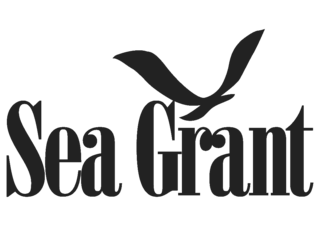
The National Sea Grant College Program is a program of the National Oceanic and Atmospheric Administration (NOAA) within the U.S. Department of Commerce. It is a national network of 34 university-based Sea Grant programs involved in scientific research, education, training, and extension projects geared toward the conservation and practical use of the coasts, Great Lakes, and other marine areas. The program is administered by the National Oceanic and Atmospheric Administration (NOAA) with the national office located in Silver Spring, Maryland. There are Sea Grant programs located in every coastal and Great Lakes state as well as in Puerto Rico and Guam.

A storm surge, storm flood, tidal surge, or storm tide is a coastal flood or tsunami-like phenomenon of rising water commonly associated with low-pressure weather systems, such as cyclones. It is measured as the rise in water level above the normal tidal level, and does not include waves.

Dead zones are hypoxic (low-oxygen) areas in the world's oceans and large lakes. Hypoxia occurs when dissolved oxygen (DO) concentration falls to or below 2 mg of O2/liter. When a body of water experiences hypoxic conditions, aquatic flora and fauna begin to change behavior in order to reach sections of water with higher oxygen levels. Once DO declines below 0.5 ml O2/liter in a body of water, mass mortality occurs. With such a low concentration of DO, these bodies of water fail to support the aquatic life living there. Historically, many of these sites were naturally occurring. However, in the 1970s, oceanographers began noting increased instances and expanses of dead zones. These occur near inhabited coastlines, where aquatic life is most concentrated.
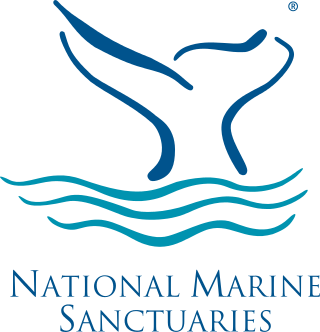
A U.S. National Marine Sanctuary is a zone within United States waters where the marine environment enjoys special protection. The program began in 1972 in response to public concern about the plight of marine ecosystems.

Oceanic and Atmospheric Research (OAR) is a division of the National Oceanic and Atmospheric Administration (NOAA). OAR is also referred to as NOAA Research.
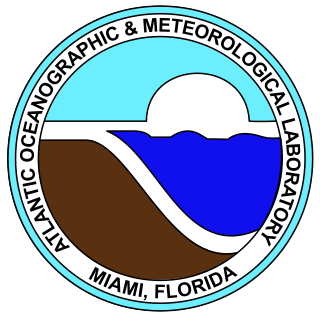
The Atlantic Oceanographic and Meteorological Laboratory (AOML), a federal research laboratory, is part of the National Oceanic and Atmospheric Administration's (NOAA) Office of Oceanic and Atmospheric Research (OAR), located in Miami in the United States. AOML's research spans tropical cyclone and hurricanes, coastal ecosystems, oceans and human health, climate studies, global carbon systems, and ocean observations. It is one of seven NOAA Research Laboratories (RLs).

The Cooperative Institute for Great Lakes Research, formerly known as the Cooperative Institute for Limnology and Ecosystems Research, fosters research collaborations between the National Oceanic and Atmospheric Administration (NOAA) Office of Oceanic and Atmospheric Research (OAR) Great Lakes Environmental Research Laboratory (GLERL), Michigan State University (MSU), and the University of Michigan (UM). It is one of 16 NOAA Cooperative Institutes (CIs).
The Cooperative Institute for Marine and Atmospheric Studies (CIMAS) is a research institute of the University of Miami located in its Rosenstiel School of Marine and Atmospheric Science (RSMAS) in Miami, Florida.
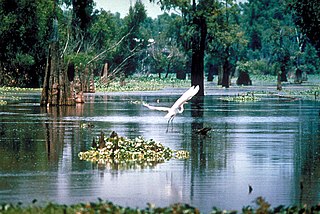
The wetlands of Louisiana are water-saturated coastal and swamp regions of southern Louisiana, often called 'Bayou'.

The Chenière Caminada hurricane, also known as the Great October Storm, was a powerful hurricane that devastated the island of Cheniere Caminada, Louisiana in early October 1893. It was one of three deadly hurricanes during the 1893 Atlantic hurricane season; the storm killed an estimated 2,000 people, mostly from storm surge. The high death toll ranks the hurricane as the deadliest hurricane in Louisiana history and the third deadliest hurricane in the continental U.S., behind only the 1900 Galveston hurricane and the 1928 Okeechobee hurricane.
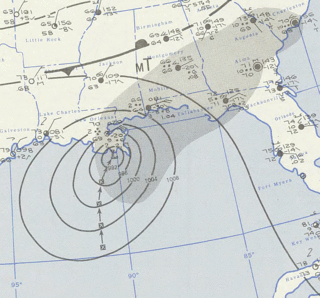
Hurricane Flossy originated from a tropical disturbance in the eastern Pacific Ocean and moved across Central America into the Gulf of Mexico as a tropical depression on September 21, 1956, which became a tropical storm on September 22 and a hurricane on September 23. The hurricane peaked with maximum sustained winds of 90 mph (140 km/h) before it struck the central Gulf coast of the United States as a Category 1 hurricane on September 24, and evolved into an extratropical cyclone on September 25. It was the first hurricane to affect oil refining in the Gulf of Mexico. The tropical cyclone led to flooding in New Orleans, and broke a drought across the eastern United States. The death toll was 15, and total damages reached $24.8 million (1956 USD).

The National Oceanic and Atmospheric Administration Fisheries Office of Law Enforcement is a federal police part of the National Marine Fisheries Service of the National Oceanic and Atmospheric Administration, headquartered in Silver Spring, Maryland. The leadership consists of Director James Landon, Deputy Director Logan Gregory, Assistant Director Todd Dubois, and Budget Chief Milena Seelig.

The Gulf of Mexico is an ocean basin and a marginal sea of the Atlantic Ocean, mostly surrounded by the North American continent. It is bounded on the northeast, north and northwest by the Gulf Coast of the United States; on the southwest and south by the Mexican states of Tamaulipas, Veracruz, Tabasco, Campeche, Yucatán, and Quintana Roo; and on the southeast by Cuba. The Southern U.S. states of Texas, Louisiana, Mississippi, Alabama, and Florida, which border the Gulf on the north, are often referred to as the "Third Coast" of the United States.
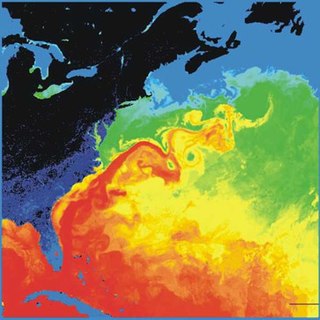
The Gulf Stream, together with its northern extension the North Atlantic Drift, is a warm and swift Atlantic ocean current that originates in the Gulf of Mexico and flows through the Straits of Florida and up the eastern coastline of the United States, then veers east near 36°N latitude and moves toward Northwest Europe as the North Atlantic Current. The process of western intensification causes the Gulf Stream to be a northward-accelerating current off the east coast of North America. Around 40°0′N30°0′W, it splits in two, with the northern stream, the North Atlantic Drift, crossing to Northern Europe and the southern stream, the Canary Current, recirculating off West Africa.
Nancy Nash Rabalais is an American marine ecologist. Born in Wichita Falls, Texas, she is the daughter of Kathryn Charlotte Preusch and Stephen Anthony Nash, a mechanical engineer, and the second of four children. She researches dead zones in the marine environment and is an expert in eutrophication and nutrient pollution.
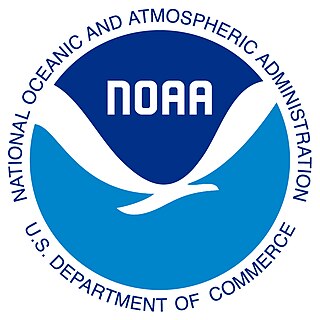
The National Centers for Environmental Information (NCEI) is a U.S. government agency that manages one of the world’s largest archives of atmospheric, coastal, geophysical, and oceanic data. The current director is Derek Arndt.
Gordon Pennington Gunter was an American marine biologist and fisheries scientist. He is noted for his pioneering study of fisheries in the northern Gulf of Mexico, a topic to which he devoted his entire professional life over a career spanning 60 years. His own research, and that of the scientists under his direction, established an understanding of the ecology, comparative physiology of the plant and animal life, and commercial fisheries of the region, and he coined the phrase "fertile fisheries crescent" to refer to Mississippi Sound and adjacent waters along the United States Gulf Coast. He also pioneered the study of the comparative physiology of shellfish and fish.

Coral Reef Conservation Program (CRCP) is a partnership between National Oceanic and Atmospheric Administration (NOAA) agencies, established in 2000. The program is a multidisciplinary approach, initiated by the NOAA, to managing and understanding coral reef ecosystems through research and the publication of data to support relevant partners involved in coral reef restoration.
















